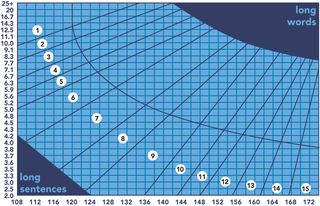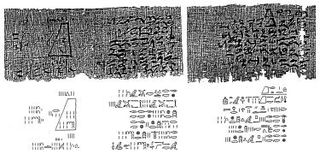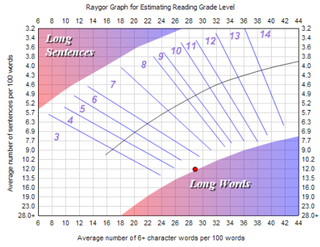
In statistics, the standard deviation is a measure of the amount of variation of the values of a variable about its mean. A low standard deviation indicates that the values tend to be close to the mean of the set, while a high standard deviation indicates that the values are spread out over a wider range. The standard deviation is commonly used in the determination of what constitutes an outlier and what does not.
Plain language is writing designed to ensure the reader understands as quickly, easily, and completely as possible. Plain language strives to be easy to read, understand, and use. It avoids verbose, convoluted language and jargon. In many countries, laws mandate that public agencies use plain language to increase access to programs and services. The United Nations Convention on the Rights of Persons with Disabilities includes plain language in its definition of communication.
Readability is the ease with which a reader can understand a written text. The concept exists in both natural language and programming languages though in different forms. In natural language, the readability of text depends on its content and its presentation. In programming, things such as programmer comments, choice of loop structure, and choice of names can determine the ease with which humans can read computer program code.

The hemocytometer is a counting-chamber device originally designed and usually used for counting blood cells.

The standard error (SE) of a statistic is the standard deviation of its sampling distribution or an estimate of that standard deviation. If the statistic is the sample mean, it is called the standard error of the mean (SEM). The standard error is a key ingredient in producing confidence intervals.
In environmental chemistry, the chemical oxygen demand (COD) is an indicative measure of the amount of oxygen that can be consumed by reactions in a measured solution. It is commonly expressed in mass of oxygen consumed over volume of solution, which in SI units is milligrams per liter (mg/L). A COD test can be used to quickly quantify the amount of organics in water. The most common application of COD is in quantifying the amount of oxidizable pollutants found in surface water or wastewater. COD is useful in terms of water quality by providing a metric to determine the effect an effluent will have on the receiving body, much like biochemical oxygen demand (BOD).

The Flesch–Kincaid readability tests are readability tests designed to indicate how difficult a passage in English is to understand. There are two tests: the Flesch Reading-Ease, and the Flesch–Kincaid Grade Level. Although they use the same core measures, they have different weighting factors.
A golf handicap is a numerical measure of a golfer's ability, or potential ability, that is used to enable players of different abilities to compete against one another. Better players are those with the lowest handicaps.
In linguistics, the Gunning fog index is a readability test for English writing. The index estimates the years of formal education a person needs to understand the text on the first reading. For instance, a fog index of 12 requires the reading level of a United States high school senior. The test was developed in 1952 by Robert Gunning, an American businessman who had been involved in newspaper and textbook publishing.

In mathematics, the Pell numbers are an infinite sequence of integers, known since ancient times, that comprise the denominators of the closest rational approximations to the square root of 2. This sequence of approximations begins 1/1, 3/2, 7/5, 17/12, and 41/29, so the sequence of Pell numbers begins with 1, 2, 5, 12, and 29. The numerators of the same sequence of approximations are half the companion Pell numbers or Pell–Lucas numbers; these numbers form a second infinite sequence that begins with 2, 6, 14, 34, and 82.

The Fry readability formula is a readability metric for English texts, developed by Edward Fry.
The automated readability index (ARI) is a readability test for English texts, designed to gauge the understandability of a text. Like the Flesch–Kincaid grade level, Gunning fog index, SMOG index, Fry readability formula, and Coleman–Liau index, it produces an approximate representation of the US grade level needed to comprehend the text.
The Coleman–Liau index is a readability test designed by Meri Coleman and T. L. Liau to gauge the understandability of a text. Like the Flesch–Kincaid Grade Level, Gunning fog index, SMOG index, and Automated Readability Index, its output approximates the U.S. grade level thought necessary to comprehend the text.

The normalized difference vegetation index (NDVI) is a widely-used metric for quantifying the health and density of vegetation using sensor data. It is calculated from spectrometric data at two specific bands: red and near-infrared. The spectrometric data is usually sourced from remote sensors, such as satellites.

The Moscow Mathematical Papyrus, also named the Golenishchev Mathematical Papyrus after its first non-Egyptian owner, Egyptologist Vladimir Golenishchev, is an ancient Egyptian mathematical papyrus containing several problems in arithmetic, geometry, and algebra. Golenishchev bought the papyrus in 1892 or 1893 in Thebes. It later entered the collection of the Pushkin State Museum of Fine Arts in Moscow, where it remains today.
The pavement condition index (PCI) is a numerical index between 0 and 100, which is used to indicate the general condition of a pavement section. The PCI is widely used in transportation civil engineering and asset management, and many municipalities use it to measure the performance of their road infrastructure and their levels of service. It is a statistical measure and requires manual survey of the pavement. This index was originally developed by the United States Army Corps of Engineers as an airfield pavement rating system, but later modified for roadway pavements and standardized by the ASTM. The surveying processes and calculation methods have been documented and standardized by ASTM for both roads and airport pavements:

The Raygor estimate graph is a readability metric for English text. It was developed by Alton L. Raygor, who published it in 1977.
Linsear Write is a readability metric for English text, purportedly developed for the United States Air Force to help them calculate the readability of their technical manuals. It is one of many such readability metrics, but is specifically designed to calculate the United States grade level of a text sample based on sentence length and the number of words used that have three or more syllables. It is similar to the Fry readability formula.
The Spache readability formula is a readability test for writing in English, designed by George Spache. It works best on texts that are for children up to fourth grade. For older children, the Dale–Chall readability formula is more appropriate.
The Dale–Chall readability formula is a readability test that provides a numeric gauge of the comprehension difficulty that readers come upon when reading a text. It uses a list of 3000 words that groups of fourth-grade American students could reliably understand, considering any word not on that list to be difficult.








